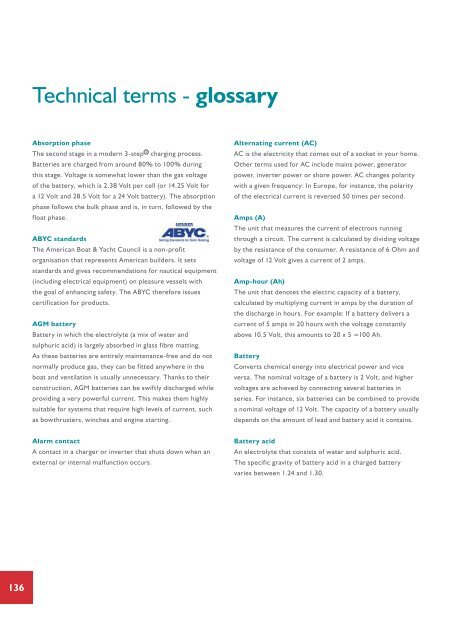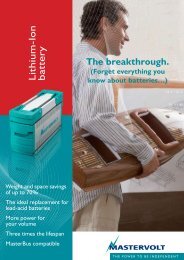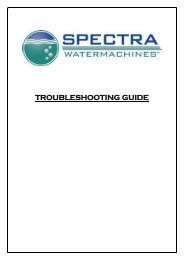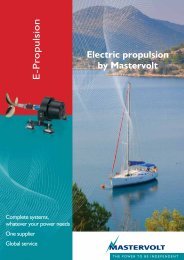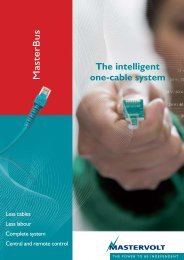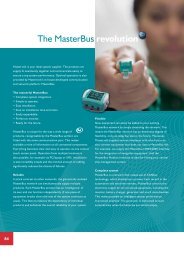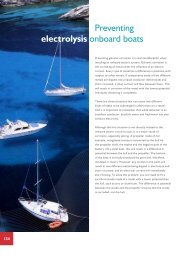Technical terms - glossary - Hybridenergy.com.au
Technical terms - glossary - Hybridenergy.com.au
Technical terms - glossary - Hybridenergy.com.au
Create successful ePaper yourself
Turn your PDF publications into a flip-book with our unique Google optimized e-Paper software.
<strong>Technical</strong> <strong>terms</strong> - <strong>glossary</strong><br />
Absorption phase<br />
The second stage in a modern 3-step charging process.<br />
Batteries are charged from around 80% to 100% during<br />
this stage. Voltage is somewhat lower than the gas voltage<br />
of the battery, which is 2.38 Volt per cell (or 14.25 Volt for<br />
a 12 Volt and 28.5 Volt for a 24 Volt battery). The absorption<br />
phase follows the bulk phase and is, in turn, followed by the<br />
float phase.<br />
ABYC standards<br />
The American Boat & Yacht Council is a non-profit<br />
organisation that represents American builders. It sets<br />
standards and gives re<strong>com</strong>mendations for n<strong>au</strong>tical equipment<br />
(including electrical equipment) on pleasure vessels with<br />
the goal of enhancing safety. The ABYC therefore issues<br />
certification for products.<br />
AGM battery<br />
Battery in which the electrolyte (a mix of water and<br />
sulphuric acid) is largely absorbed in glass fibre matting.<br />
As these batteries are entirely maintenance-free and do not<br />
normally produce gas, they can be fitted anywhere in the<br />
boat and ventilation is usually unnecessary. Thanks to their<br />
construction, AGM batteries can be swiftly discharged while<br />
providing a very powerful current. This makes them highly<br />
suitable for systems that require high levels of current, such<br />
as bowthrusters, winches and engine starting.<br />
Alternating current (AC)<br />
AC is the electricity that <strong>com</strong>es out of a socket in your home.<br />
Other <strong>terms</strong> used for AC include mains power, generator<br />
power, inverter power or shore power. AC changes polarity<br />
with a given frequency: In Europe, for instance, the polarity<br />
of the electrical current is reversed 50 times per second.<br />
Amps (A)<br />
The unit that measures the current of electrons running<br />
through a circuit. The current is calculated by dividing voltage<br />
by the resistance of the consumer. A resistance of 6 Ohm and<br />
voltage of 12 Volt gives a current of 2 amps.<br />
Amp-hour (Ah)<br />
The unit that denotes the electric capacity of a battery,<br />
calculated by multiplying current in amps by the duration of<br />
the discharge in hours. For example: If a battery delivers a<br />
current of 5 amps in 20 hours with the voltage constantly<br />
above 10.5 Volt, this amounts to 20 x 5 =100 Ah.<br />
Battery<br />
Converts chemical energy into electrical power and vice<br />
versa. The nominal voltage of a battery is 2 Volt, and higher<br />
voltages are achieved by connecting several batteries in<br />
series. For instance, six batteries can be <strong>com</strong>bined to provide<br />
a nominal voltage of 12 Volt. The capacity of a battery usually<br />
depends on the amount of lead and battery acid it contains.<br />
Alarm contact<br />
A contact in a charger or inverter that shuts down when an<br />
external or internal malfunction occurs.<br />
Battery acid<br />
An electrolyte that consists of water and sulphuric acid.<br />
The specific gravity of battery acid in a charged battery<br />
varies between 1.24 and 1.30.<br />
136
Battery charger<br />
Used to charge batteries. Its capacity should be around 15 to<br />
25% of the battery capacity with a wet battery, 30% with an<br />
AGM battery, up to 50% with a gel battery and 100% with a<br />
Lithium Ion battery.<br />
Battery monitor (or battery consumption meter)<br />
Indicates battery status. Mastervolt offers two different<br />
models: The conventional BTM-III provides information about<br />
charge and discharge current, battery voltage, number of<br />
amp-hours consumed and time remaining before recharging<br />
be<strong>com</strong>es necessary. The modern MasterShunt gives<br />
extensive information on current, voltage, historical data and<br />
information on usage. It is easy to connect to the MasterBus<br />
network and with its integrated system clock <strong>com</strong>bined with<br />
<strong>com</strong>mand-based events you can program the system entirely<br />
to your wishes.<br />
Bulk phase<br />
The first stage in a modern 3-step charging system. The<br />
output current of the battery charger is 100% during this<br />
stage, while voltage depends on the power remaining in the<br />
battery. The bulk phase is followed by the absorption phase.<br />
BV approval<br />
Bure<strong>au</strong> Veritas is a French classification society for shipping,<br />
passenger vessels and some large yachts. The<br />
requirements in <strong>terms</strong> of safety and functionality<br />
are stringent and approval is required by many<br />
insurance <strong>com</strong>panies. Most Mastervolt<br />
equipment exceeds BV’s rigorous standards.<br />
Cable losses<br />
A loss of voltage resulting from the resistance of the cable<br />
during the conduction of electric current.<br />
CE mark<br />
Marking placed on a product by<br />
manufacturers or importers to declare<br />
that it meets EU safety, health and<br />
environmental requirements. These requirements are<br />
derived from European product directives, which have<br />
been incorporated into the national legislation of most<br />
EU member states. The CE mark therefore shows<br />
<strong>com</strong>pliance with a law and is not informal advice.<br />
It should be visible on the outside of equipment and<br />
suppliers have to make available a declaration stating<br />
which requirements of the CE marking the equipment<br />
meets. All Mastervolt equipment exceeds these<br />
rigorous standards.<br />
137
Charge voltage<br />
Voltage used to charge batteries. On average, it amounts to<br />
14.25 Volt or 28.5 Volt during the absorption phase and 13.25<br />
Volt and 26.5 Volt during the float phase at 25 °C.<br />
Combi<br />
A device that <strong>com</strong>bines a battery charger, an inverter and a<br />
transfer system in one.<br />
Cos phi or power factor<br />
Specifies the degree to which current is out of phase with<br />
voltage: The lower this value, the larger the discrepancy. In<br />
a heating element, for instance, the current is in phase with<br />
the voltage, so the cos phi is 1. In a motor, however, there is<br />
a divergence, and cos phi tends to be 0.8 or sometimes 0.6.<br />
The lower the cos phi, the more current is required to supply<br />
a given amount of power.<br />
Current<br />
The flow of electrons through a circuit, which can be <strong>com</strong>pared<br />
to the flow of water. Electric current is measured in amps.<br />
Cycle<br />
The discharging of a battery from 100% to 0% and recharging<br />
back from 0% to 100% in one cycle. Twice discharging to 50%<br />
and fully recharging is also one cycle, as is four times discharging<br />
to 75% and fully recharging again. This is all theory, however:<br />
In practice a battery is never discharged more than 50%.<br />
Digital Switching<br />
Digital Switching is a Mastervolt innovation that radically<br />
simplifies installation, configuration, control and monitoring<br />
of onboard electrical systems. It also offers you a range of<br />
luxurious and <strong>com</strong>fortable options, including remote control<br />
by mobile telephone. Digital switching is fully <strong>com</strong>patible with<br />
a MasterBus network (see MasterBus).<br />
138
Dipswitch<br />
A tiny switch usually found on a printed circuit board and<br />
used to set the various functions of Mastervolt equipment.<br />
Direct current (DC)<br />
Current that only flows in one direction, such as that in a<br />
battery, solar panel, alternator or battery charger.<br />
DNV approval<br />
Det Norske Veritas is a Norwegian classification<br />
society for professional shipping and offshore<br />
activities. The requirements in term of safety and functionality<br />
are very strict, and approval is required by many insurance<br />
<strong>com</strong>panies. Most Mastervolt equipment easily satisfies DNV’s<br />
stringent standards.<br />
Earth<br />
The electric no-load potential, also called reference potential.<br />
The negative pole of a battery is often connected to the steel<br />
chassis of a vehicle or boat, which then serves as the earth. In<br />
US English the term grounding is used.<br />
Earth leakage switch<br />
Monitors the onboard supply for electrical leakage, switching<br />
it off when leakage exceeds 30 milli-amps. An earth leakage<br />
switch protects you against an electric shock in the event of<br />
contact with a live <strong>com</strong>ponent.<br />
Efficiency<br />
The efficiency of a power source is expressed in percentage<br />
<strong>terms</strong> (%). A device with an efficiency of 90%, for instance,<br />
has 100% power at the beginning and 90% at the end. The<br />
10% that is lost is primarily transformed into heat. The higher<br />
the efficiency of an inverter, the longer the batteries will last.<br />
Electrolyte<br />
The liquid in batteries, <strong>com</strong>posed of a mixture of sulphuric<br />
acid and water. Its specific gravity is 1.280 in a charged<br />
battery and 1.100 in a discharged one.<br />
E-marking<br />
A standard that indicates whether the relevant equipment can<br />
be used on vehicles such as ambulances and fire engines. In<br />
order to qualify for an E-marking, equipment has to<br />
satisfy strict requirements in <strong>terms</strong> of safety, EMC and<br />
suitability. Most Mastervolt battery chargers and inverters<br />
<strong>com</strong>ply with these requirements and all have an E-marking.<br />
EMC<br />
Short for Electro-Magnetic Compatibility, EMC indicates<br />
how much, if any, electromagnetic interference a device<br />
may produce and whether it is sensitive to electromagnetic<br />
interference from the outside. A good example is that of a<br />
battery charger and a microwave oven. The microwave is<br />
not allowed to produce more interference than determined by<br />
the EMC standard, and the battery charger may not be<br />
affected by the interference generated by the microwave.<br />
Naturally, the opposite also holds true. Requirements in <strong>terms</strong><br />
of EMC are established within the CE framework. Mastervolt<br />
equipment more than meets these strict requirements.<br />
E-Propulsion<br />
Electrical propulsion is growing in popularity and is<br />
<strong>com</strong>pulsory in an increasing number of sailing and nature<br />
areas. A hybrid version is also available, allowing you to<br />
choose whether to sail using a diesel engine or electric motor.<br />
139
Float phase<br />
The final step in a modern 3-step charging process. Although<br />
the batteries are full during this phase they receive a<br />
maintenance charge, while the onboard DC circuit is<br />
supplied with power. Charge voltage is 2.25 Volt per cell or<br />
13.25 Volt for 12 Volt batteries and 26.5 Volt for 24 Volt ones<br />
at an ambient temperature of 25 °C.<br />
Forced inverter<br />
A function on the Mass Systemswitch. At the push of a<br />
button, a part of the onboard consumers are powered from<br />
the batteries via the inverter, while the battery charger stays<br />
connected to shore power. The power intake of the battery<br />
charger can be regulated via the system panel, up to the<br />
point where the maximum for the shore power fuse has been<br />
reached. The advantage of this system is that heavy-duty<br />
consumers such as hair dryers are powered via the inverter<br />
and cannot therefore overload the shore power fuse. When<br />
such consumers are connected to the inverter, consumption<br />
from the batteries is usually higher than the battery charger<br />
can supply. This is rarely a problem as major consumers are<br />
usually used for a short time and the consumption measured in<br />
Ah tends to be low. After the consumer has been switched off<br />
the battery charger will recharge the battery <strong>au</strong>tomatically.<br />
Gel battery<br />
Batteries where the electrolyte (mix of water and sulphuric<br />
acid) is absorbed in a gel. As they are entirely maintenance<br />
free and rarely produce gas, gel batteries can be fitted<br />
anywhere onboard a boat. Extra gas extraction is usually<br />
unnecessary. Gel batteries are highly suitable for lighting<br />
and as onboard service batteries, and can be charged very<br />
quickly thanks to their special construction. With normal use<br />
the lifespan of a 12 Volt gel battery is between six and seven<br />
years. For the 2 Volt traction gel version, 10 to 15 years is<br />
not un<strong>com</strong>mon. A gel battery is very suitable for (deep)<br />
cycle usage.<br />
GL approval<br />
Germanischer Lloyd is a German classification<br />
society for professional marine vessels.<br />
The requirements in <strong>terms</strong> of safety and<br />
functionality are very strict and this approval<br />
is often necessary for insurance purposes.<br />
Hertz (Hz)<br />
Unit that measures frequency, i.e.the number of times per<br />
second that an alternating current (AC) changes direction.<br />
In Europe this is 50 Hz, and in the USA 60 Hz.<br />
Frequency<br />
The number of times per second that alternating current<br />
changes direction, expressed in Hertz (Hz).<br />
Galvanic isolation<br />
A situation where two circuits are electrically connected<br />
without their grounding or earth <strong>com</strong>ing in contact. Galvanic<br />
isolation is best achieved by means of a transformer.<br />
Gas voltage<br />
The voltage level at which a battery starts producing gas. At<br />
at an ambient temperature of 25 ºC, the gas voltage is 2.38<br />
Volt per cell or 14.25 Volt for a 12 Volt battery and 28.5 Volt<br />
for a 24 Volt one.<br />
High-frequency (HF) switch technology<br />
This technology allows in<strong>com</strong>ing alternating current to be<br />
rectified into direct current over a diode bridge, making large<br />
transformers obsolete. The resulting DC voltage is chopped<br />
into parts with a high frequency by means of an electronic<br />
switch that is turned on and off quickly. This creates a<br />
simulated alternating current with a high frequency, 35 kHz<br />
(35,000 Hertz) for instance. This AC can be converted to<br />
a higher or lower voltage via a very small transformer. The<br />
higher the frequency, the smaller the transformer can be.<br />
Mastervolt uses HF switch technology in all its equipment,<br />
offering major benefits in <strong>terms</strong> of <strong>com</strong>pactness, weight and<br />
efficiency. Another advantage is that you say goodbye to the<br />
irritating hum of a transformer.<br />
140
IEC approval<br />
The International Electrotechnical Commission (IEC) is<br />
headquartered in Geneva, Switzerland, and develops general<br />
standards for the safety of electrical <strong>com</strong>ponents and<br />
equipment. Although it proposes standards, the IEC is not<br />
responsible for their enforcement, which is usually carried<br />
out by independent test laboratories.<br />
Inductive loads<br />
These loads are created by, for example, the motors in air<br />
conditioning systems and diving <strong>com</strong>pressors. They c<strong>au</strong>se the<br />
current to flow out of phase with the voltage, a phenomenon<br />
also known as phase shift. The degree is indicated by a value,<br />
cos phi, which ranges from 0 to 1 and is inversely proportionate<br />
to the size of the lag. In a heating element (which is resistive<br />
load), current flows in step with voltage and cos phi is 1. In a<br />
motor, however, there will be a lag, as indicated by the typical<br />
value of 0.8 - or sometimes 0.6 - for cos phi. The lower the<br />
cos phi, the greater the lag, and the more current is necessary<br />
to supply a given level of power.<br />
Inverter<br />
Converts 12, 24 or 48 Volt battery power to alternating<br />
current at 230 V/50 Hz (or 120 V/60 Hz). This allows<br />
appliances such as <strong>com</strong>puters, microwave ovens and TVs<br />
to be powered without the need for a shore power<br />
connection or generator.<br />
Isolation transformer<br />
Converts shore power voltage to a higher, lower or equal<br />
value to ensure that there is galvanic isolation between<br />
the shore power connection and the onboard mains.<br />
This prevents corrosion from occurring.<br />
Kilowatt (kW)<br />
Unit for electrical power equivalent to 1000 Watt.<br />
Ten 100-Watt light bulbs consume one kilowatt.<br />
141
142
Kilowatt-hour (kWh)<br />
One kW of electricity used in the space of one hour. This is<br />
the most <strong>com</strong>mon measurement of power consumption, also<br />
used by energy <strong>com</strong>panies.<br />
LED (light emitting diode)<br />
Electronic light with very low power consumption. LEDs are<br />
generally available in many different colours and Mastervolt<br />
uses them as signal lights on battery chargers and inverters.<br />
The latest generation of LEDs can be used as lights as well<br />
and are very low in use of energy.<br />
Lithium Ion battery<br />
Lithium Ion batteries have a high energy density and are<br />
perfect for cyclic applications. Compared to traditional<br />
lead acid batteries, Lithium Ion batteries offer savings of up<br />
to 70% in volume and weight, while the number of charging<br />
cycles is three times as large. Another major benefit of the<br />
Mastervolt Lithium Ion battery is that it is equipped with an<br />
integrated Cell Management System, which <strong>au</strong>tomatically<br />
<strong>com</strong>pensates for any imbalance between the cells to<br />
guarantee a longer battery lifespan.<br />
Lloyd’s approval<br />
Lloyd’s Register of Shipping is a British<br />
classification society for yachts, professional<br />
shipping, drilling platforms, etc. Numerous<br />
insurance <strong>com</strong>panies require large vessels to<br />
be approved by Lloyd’s. This means that the vessel and the<br />
onboard equipment have to satisfy stringent requirements.<br />
MasterBus<br />
MasterBus is Mastervolt’s advanced standard for data<br />
<strong>com</strong>munication and integration of <strong>com</strong>ponents within your<br />
electric system. Advantages include <strong>com</strong>plete system<br />
integration, easy operation and monitoring, and simple<br />
installation with fewer cables. A MasterBus network can be<br />
easily extended at a later date.<br />
NiCad batteries<br />
Containing nickel, cadmium and lead, this type of battery is<br />
unsuitable for use on boats due to the high charge voltage<br />
required. NiCad batteries will soon be banned bec<strong>au</strong>se of<br />
their cadmium content. N.B. All batteries are considered to<br />
be chemical waste.<br />
No-load consumption<br />
Power consumed by an inverter when it is not powering any<br />
equipment. This is just a few Watts with modern Mastervolt<br />
inverters and Combis. The lower the no-load consumption,<br />
the less power is used by the inverter.<br />
Ohm<br />
Unit for electrical resistance, indicated by the symbol Ω.<br />
Ohm’s law<br />
Gives the relationship between voltage (U), current (I) and<br />
resistance (R). In formula <strong>terms</strong> this is expressed as U= I<br />
x R. If two of the three values are known, the third can be<br />
calculated.<br />
Oxyhydrogen<br />
Highly explosive gas mixture of hydrogen and oxygen formed<br />
during the charging of wet batteries with an unsuitable<br />
charger. Extra ventilation or gas extraction prevents<br />
concentrations from be<strong>com</strong>ing too high.<br />
Overload<br />
A concept related to the safety of an inverter, generator or<br />
shore power connection. A fuse, for instance, ensures against<br />
overload. All Mastervolt inverters have electronic protection<br />
against overload.<br />
143
Parallel connection<br />
In a parallel connection the current can flow through multiple<br />
circuits. By parallel connecting batteries (positive to positive,<br />
negative to negative), the capacity of the battery set is<br />
increased, while voltage stays the same. For example, while<br />
two 12 V/50Ah batteries connected in parallel have a voltage<br />
of 12 Volt, the capacity is 50 + 50 = 100 Ah.<br />
Peak power<br />
The maximum current that can be supplied by an inverter for<br />
short periods of time. This is often necessary, as electric<br />
motors can consume up to six times their nominal power<br />
when starting up. Mastervolt inverters deliver a high peak<br />
current, often reaching two to three times their nominal<br />
capacity.<br />
Peukert<br />
The name of a German scientist who in 1897 observed that<br />
a battery supplies progressively less power as the discharge<br />
current increases. Peukert created a formula that gives the<br />
number of amps a battery can supply at a given discharge<br />
current. Mastervolt battery monitors all take Peukert’s law<br />
into account, ensuring that you always have a correct<br />
overview of your battery’s status.<br />
Power Sharing<br />
This concept is related to the performance of the battery<br />
charger part of a Combi when connected to the onshore<br />
grid or a generator. It involves the <strong>au</strong>tomatic power intake<br />
regulation of the battery charger when the shore power is<br />
very low. As soon as the shore power fuse is in danger of<br />
being overloaded, the battery charger <strong>au</strong>tomatically reduces<br />
its current consumption.<br />
144
Power Support<br />
A feature found in, for example, the Mass Combi. Power<br />
Support ensures that the power supply to onboard<br />
consumers starts <strong>com</strong>ing from the batteries if the<br />
shore power is in danger of be<strong>com</strong>ing overloaded. It is<br />
activated after the battery charger intake has been reduced<br />
to zero via the power sharing system in the Combi.<br />
Re<strong>com</strong>bination technology<br />
Used in AGM and gel batteries to make sure that the gas<br />
(oxygen and hydrogen) generated by charging is re<strong>com</strong>bined<br />
into water. This means that the batteries can be entirely<br />
maintenance free and sealed.<br />
RMS voltmeter<br />
Device used to measure the voltage of old-fashioned<br />
trapezoidal inverters (RMS stands for Root Mean Square),<br />
for which a regular digital meter will indicate the wrong value.<br />
The output voltage of sine wave inverters can be measured<br />
with a standard digital meter.<br />
RRR approval<br />
The Russian River Register sets standards for products and<br />
manufacturers in <strong>terms</strong> of quality, safety and environmental<br />
friendliness. Only products certified by the RRR are allowed<br />
onboard vessels sailing on the country’s inland and coastal<br />
waters.<br />
Self-discharging<br />
The decrease in the capacity of a battery that occurs when<br />
no load is connected. A wet battery loses 15% per month, an<br />
AGM battery 3%, a gel battery 2% and a Lithium Ion<br />
battery less than 3% per month. The higher the ambient<br />
temperature, the more self-discharging will occur. Current<br />
leakage due to intense pollution or humidity between the<br />
poles can also c<strong>au</strong>se a higher level of self-discharging, so you<br />
should always keep the top of your batteries clean and dry.<br />
Self-discharging is <strong>au</strong>tomatically <strong>com</strong>pensated by the float<br />
phase of the battery charger.<br />
Semi-traction battery<br />
A semi-traction battery has fewer but thicker plates in each<br />
cell, <strong>com</strong>pared to other lead acid technologies. These<br />
batteries supply a relatively lower starter current, but can be<br />
discharged more often and to a greater extent (200 to 500<br />
full cycles). This kind of battery is highly appropriate for the<br />
<strong>com</strong>bined function of starter/service battery.<br />
Series connection<br />
A series connection (the positive pole of each battery is<br />
connected to the negative pole of the next) increases the<br />
voltage of the total battery set. For example, when two<br />
12 Volt batteries with a capacity of 50 Ah each are connected<br />
in series, the total voltage of the set will be 12 + 12 = 24<br />
Volt, while total capacity remains 50 Ah (current x hour).<br />
RS approval<br />
The Russian Maritime Register of Shipping sets standards<br />
that products and manufacturers must meet in order to be<br />
allowed onboard vessels flying the Russian flag within Russian<br />
territorial waters (seas and inland waters). The institute is<br />
also responsible for related inspections.<br />
Sine wave<br />
The alternation of voltage can be graphically indicated by a<br />
sine wave. This consists of a line that follows a wave pattern<br />
around a horizontal axis, which represents the passage of<br />
time and also the points at which voltage is zero. Once the<br />
line has traced one entire wave above the time axis and one<br />
entire wave below, a whole sine wave has been outlined.<br />
A single wave above or under the line is half a sine wave.<br />
145
Square millimetre (mm²)<br />
Unit in which cable diameters are measured. With a<br />
direct current system of 12 or 24 Volt, three amps should<br />
correspond to one mm² of cable thickness. For 230 Volt<br />
systems allow 6 amps for each mm².<br />
Soft start<br />
Device used to reduce the inrush current of transformers.<br />
Stand-by mode<br />
In this mode the inverter emits a small pulse instead of the<br />
usual 230 Volt output. It detects when an appliance is<br />
plugged in and the inverter <strong>au</strong>tomatically switches on,<br />
supplying 230 Volt until the output current falls below a<br />
pre-set value. When there is little or no output current, this<br />
means that no load is connected and the inverter switches<br />
back to stand-by. This system saves a great deal of energy.<br />
Starter battery<br />
Used to start engines. Although these batteries can deliver<br />
a high current, they should not be excessively or too<br />
frequently discharged and are therefore not appropriate<br />
for lighting purposes. AGM batteries are ideal to serve as<br />
starter batteries.<br />
Switch technology<br />
See High Frequency switch technology.<br />
Temperature correction<br />
If the battery temperature is lower than 25 ºC, the charge<br />
voltage should be adjusted upwards. When higher, the charge<br />
voltage needs to be reduced. This temperature correction is<br />
-30 mV per ºC for a 12 Volt battery and -60 mV per ºC for a<br />
24 Volt one. While this may seem insignificant, it is essential<br />
to ensure a long battery life.<br />
146
147
148
Temperature sensor<br />
A temperature sensor should be attached to the battery so<br />
that the charger can optimise charge voltage with respect to<br />
the battery temperature. The charge voltage depends on the<br />
battery temperature.<br />
Volt (V)<br />
Unit in which electric potential (voltage) is measured.<br />
Volt-amps (VA)<br />
Unit for measuring electrical power.<br />
Traction batteries<br />
Used for propulsion, powering marine equipment and<br />
inverters, etc. They can be discharged often and <strong>com</strong>pletely,<br />
and in a gel version are highly suitable for onboard use. Wet<br />
cell batteries are only appropriate for forklifts, etc.<br />
Transfer system<br />
A (frequently <strong>au</strong>tomatic) system used to switch between<br />
multiple power sources, such as shore power, generator and<br />
inverter.<br />
3-Step charging<br />
A modern charging technology that has been extended<br />
with an extra step in Mastervolt’s latest equipment, the<br />
Plus phase.<br />
The three steps are:<br />
• Bulk, where the charger supplies maximum power.<br />
• Absorption, during which the charger delivers maximum<br />
charge voltage and the battery is charged from around<br />
80% to 100%.<br />
• Float, used for battery maintenance and delivering power<br />
to connected equipment.<br />
The ‘plus’ phase is an <strong>au</strong>tomatic one-hour bulk phase once<br />
every 12 days when the battery is not being used.<br />
Voltage ripple<br />
A voltage ripple is a small alternating current on top of a direct<br />
current, which results in a DC voltage that is not entirely<br />
smooth but ripples slightly. While a battery delivers pure<br />
direct current without any ripple, this is not always the case<br />
with a battery charger. In an old-fashioned battery charger,<br />
50% of the voltage may contain ripples, which translates into<br />
6 Volt in a 12 Volt system. A large voltage ripple shortens the<br />
lifespan of a battery, which needs to be charged with direct<br />
(not alternating) current. In addition, a voltage ripple can<br />
interfere with onboard <strong>au</strong>dio, navigation and <strong>com</strong>munications<br />
systems. Mastervolt battery chargers supply a flat DC voltage<br />
with no more than 0.5% of ripple voltage.<br />
Watt (W)<br />
Unit that measures the rate of energy conversion, calculated<br />
by multiplying Volts by amps.<br />
Watt-hour (Wh)<br />
Measure of electrical power in time. One watt-hour of<br />
electricity is equal to one Watt of power consumed over one<br />
hour. A 10-Watt light bulb uses 10 Watt-hours of electricity in<br />
one hour (see also kWh).<br />
UL approval<br />
An American certification provided by Underwriters<br />
Laboratories that is similar to the European CE-mark and<br />
mainly focused on safety issues.<br />
149


